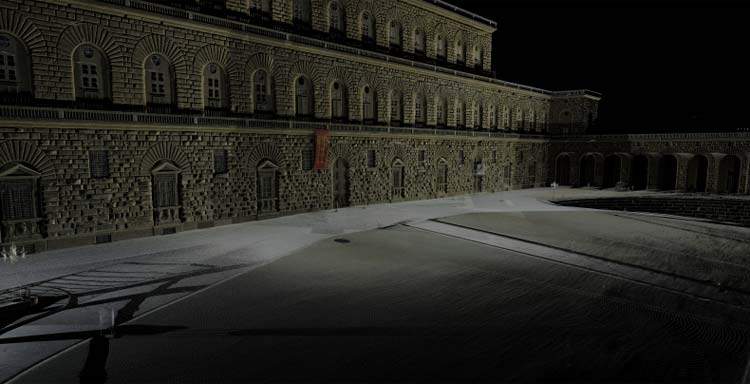Palazzo Pitti becomes 3D: for the first time, such a vast and articulated ancient complex is fully reproduced in very high definition and in every detail: exteriors, architectural structures and interiors, with all the works. The work, including topography and terrestrial photogrammetry operations and with drones, state-of-the-art laser scanning, the three-dimensional survey of the Pitti Palace was completed after a year and a half, thanks to the collaboration between the Uffizi Galleries (under the coordination of architect Elena Pozzi) and the Department of Civil and Environmental Engineering of the University of Florence (under the coordination of Professor Grazia Tucci). Many results were achieved, presented today during the study day Palazzo Pitti and its digital twin: great historic buildings in the era of technological transition.
Among them is theaccurate reconstruction of the now lost “snail” staircase, originally built in the 16th century by the famous Tuscan architect and sculptor Bartolomeo Ammannati, overlooking the inner courtyard of the palace of the same name. In fact, the comparison of the new relief of the later staircase built in the 19th century by architect Pasquale Poccianti with the archival documents reveals the full extent of the transformations that took place following his demolition of Ammannati’s staircase, bringing to light and “resurrecting,” through the 3D model, rooms whose traces had been totally lost for centuries. However, the project was not limited to the digital reproduction of the exteriors and architectural structures, but integrally recreated digitally in detail all the interiors of the Medici residence as well, including works, ornaments, furnishings and decorations.
Pitti is a building with a complex history: its transformations have been overlaid over time by a multiplicity of activities and uses that are constantly evolving. For this reason, the digitization of such a difficult case study, initiated even before the publication of the European Union Recommendation on the subject (which calls for the digitization of all at-risk cultural assets and 50 percent of the most visited monuments by 2030) now becomes a key resource.
It will not only ensure the possibility of producing 3D elaborations for all visualization uses, but it can be the foundation for the development of a multi-layered information model, where data, constantly updated in real time, can come in handy for countless purposes of knowledge, conservation, management and enhancement of heritage.
The new digital survey of the Pitti Palace also lays the groundwork for a sustainable use of the building, in line with the needs dictated by climate change and hydrogeological and natural hazards, which require a new approach to digital documentation, especially in terms of rapid data acquisition and content production methodologies, information sharing and multidisciplinary collaboration.
“The Uffizi,” says director Eike Schmidt, “once again confirms itself at the forefront of technological development: the digital twin, faithful down to the millimeter, of the Pitti Palace is not only of enormous value as a documentation of the Reggia’s status, but also offers data for historical knowledge and research. But it looks not only at the past and present, but also at the future: it is a very important tool for maintenance and restoration planning. Not least, it will be possible to develop experiences for visitors in which they will be able to see spaces not normally accessible, as well as the birth and ’growth’ of the Palace through the centuries.”
“The 3-D model, which is derived from surveying with geomatics methodologies,” says Grazia Tucci, associate professor of topography and cartography at the University of Florence, “must be a useful tool for knowledge, conservation and management of the building, but for this to happen, it is imperative to create a management model for thearchiving, preservation and updating of survey data if we do not want to thwart the results in a few years and if we really want to respond to the demands of the national digitization plan, investing the processes and not just producing results to be archived in some mass memory, transposition of the old drawer, in which so many glorious surveys ended up in the past.”
“In perspective,” stresses Elena Pozzi, architect and curator of the architectural heritage of the Pitti Palace, “the three-dimensional data model will allow the administration to more efficiently care for, maintain and enhance the architectural complex, integrating geometric, material, historical, thermo-hydrometric information, and more... in short, to create a system that perfectly simulates the behavior of the complex, offering all the data necessary for the preservation of the very rich heritage, movable and immovable of the former palace.”
 |
| Pitti Palace goes 3D: work on digital model of Florentine palace finished |
Warning: the translation into English of the original Italian article was created using automatic tools. We undertake to review all articles, but we do not guarantee the total absence of inaccuracies in the translation due to the program. You can find the original by clicking on the ITA button. If you find any mistake,please contact us.